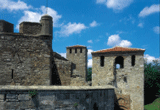|

| Vidin - City and District
Information |
 |
|
Vidin Basic Data
| City Population: |
58,360 |
| District Population: |
130,094 |
| Area size: |
3,022 square km. |
| Places of interest: |
Belogradchik, Koula, Gramada, Dimovo |
Vidin General Information
Vidin district is located in the northwestern part of Bulgaria and covers a territory of 3,022 square kilometers, which is 2.7% of the country’s total. To the north it borders the Danube and is naturally connected to Romania and the other Danubian countries. To the west its border (Timok River) tallies with the Bulgarian - Serbian boundary. To the east it neighbors the Montana district and to the south it is surrounded by the Balkan Mountains. Vidin is located in the lowest terrace of the Vidin Lowland, 35 meters above sea level, with a slight north-northeast grade (0.5% to 4%).
The density of the population in Vidin district is 42 people per square km. 75, 000 people live in the urban area, while 55,000 live in the rural, which is relatively low degree of urbanization. In terms of the age of the population, the common tendency for the country is that the portion of people 65 years old or more is growing up, while the portion of children 15 years old or less is going down – a proof of the fact that the nation is getting old.
In the region is located the only gypsum field in Bulgaria, it is in Koshava village and is on national importance. The soils in the plain are humus, fertile soils, suitable for wheat, corn, vines, lucerne, sugar beet, barley, potatoes. The climate is favorable for the development of farming and agriculture. There are more than 10 small rivers, 30 small dams and underground rivers.
Vidin has a semi-circular shape, with streets and buildings oriented to the river. A large park with beaches and recreation areas is located along the riverbank. The municipality’s total area is 501,281 decares, of which: 374,416 decares of agricultural land (incl. 337,207 decares of arable land); 44,011 decares of forests; 33,506 decares of water areas; 14,974 decares of irrigated areas; and 43,639 decares populated areas. Vidin has two summer-house areas, the Bozhuritsa area (grade I) and Sinagovsko Burdo (grade II). The distance to Bulgaria’s capital, Sofia, is 200 kilometers. Geographically, the municipality’s location makes it well-accessible and predetermines its importance to the national and the European transport systems. The north-south transport corridor No. 4 is the shortest road connecting the countries in Western, Middle and Eastern Europe. Being an important transport hub is a great resource and a prerequisite for the construction of a second bridge over the Danube. Vidin’s location makes the town easily accessible and determines its importance for the national and the European transport networks. Two European transport corridors cross the municipality: No. 4 - Kraiova (Romania) - Vidin - Sofia - Koulata; and No. 7 along the Danube. The city of Vidin is the best place for the construction of a second bridge on the Danube. The EU has made a decision that will make the bridge a reality. The Vidin North port is located close to the city, on a 9 kilometer section along the riverbank, in the immediate vicinity of the ferryboat and the duty free zone. Municipality of Vidin is connected to all communities within the country and to the border checkpoints via roads and railroads. Railroads have a great importance for the municipality. On the average, 10 trains depart and arrive at the Vidin passenger train station. The freight train station is comparatively new, on an area of 230 decares. Its capacity is 20-30 tons of loading/unloading works and freight processing per day. At present, it is not being utilized at full capacity.
Cultural sites in the region:
- the Baba Vida Fortress, supposedly in existence since the 3rd – 4th centuries in the northeastern part of the Roman Bononia Fortress;
- the Magurata Cave (Rabisha village), with some 700 rock drawings which form the biggest proto-historical gallery on the Balkan peninsula;
- the Kaleto - a system of coastal fortifications along the Danube;
- Ratziaria, which used to be a Roman City, located 17 km to the south of the town of Vidin. It provides good conditions for recreation and fishing;
- the Krastata Kazarma, built in 1798 by Polish architects for the soldiers of Osman Pazvantoglou, an independent local “pasha”;
- Pazvantoglou’s mosque and library, built up in 1800;
- the Konaka Otoman Camp, an architectural monument in existence since the second half of 18th century;
- the Rocks of Belogradchick, unique rocky formations situated near the town of Belogradchick, 52 kilometers southwest of Vidin.
The Vidin district is famous for its folklore and modern arts festivals, attended by local and international artists who exhibit their paintings, sculptures and woodcarving work.
The Fortress of Belogradchik:
The Fortress of Belogradchik is an impressive architectural-constructional and historical monument of the culture. It is situated in the south of Vidin between Peak Kom and Peak Vrushka Chuka. The slender silhouette of the fortress enters perfectly in the space surrounded by the reddish rock massifs dominating over Belogradchik.
The unique rocks of Belogradchik were molded by the nature in the course of 200 millions of years.
Their formation has started as a result of the Early-Alpine tectonic cycle, when the red sandstones and limestones were on the bottom of the huge sea and the earlier folded Paleozoic rocks remained on dry land and began to deform. The character red colour is due to iron oxides and hydroxides.
The processes of weathering, detonation, river erosion, freezing, growth of moss and lichen, as well as other natural factors that lasted for millenniums, resulted in the formation of a multitude of fantastic figures and compositions. Not great imagination is required to recognize in the rocks "The School Girl", "The Mushrooms", "Haidouk Velko", "The Bear", "The Eagle" "The Madonna”, "The Monks" and many others. During his journey in the region Konstantin Irechek exclaimed: "This cannot be described, it has to be seen!"
The Fortress of Belogradchik has risen during the 1st - 3rd A.D. centuries as a small fortress-rampart. The builder has used skillfully the inaccessibility of the elliptic rock terrace – “first plate” and has organized a structure that fulfilled defensive, observation, protective and communication functions. During archeological excavations were found bases of walls, ceramic fragments, iron spear and arrow gads, coins from Roman emperors – from the ruling of Vespasian, Trajan, Septimius Severus, Gordian III, Decii Trajan. Still may be seen Beds of rectangular beams, of light buildings and chutes, which were taking the atmospheric waters to an 85 m3 capacity water reservoir.
The Fortress was active also during the late antiquity. The ruler of Vidin – Ivan Stratsimir (1355 - 1396) evaluated its strategic significance. During his time it was additionally reinforced and enlarged. Two partition walls and auxiliary buildings were built. The hanging wooden bridges and the stone staircases were providing better possibilities for quick maneuvering.
The chronicle tells that within three months from the conquest of Bdin (Vidin) on 2 June 1365, all remaining in the area fortress were also captured, including the fortress Fehervar (Belogradchik). The garrison, which was placed in the fortress, was expelled by rebelling Bulgarians in 1369.
Also in 1369 the fortress was captured by Ottomans and partially destroyed. In 1454 - 1455 an 8-person guard was placed in it; 100 years later the garrison already consisted of 27 people and one dizdar (chief). Till the beginning of the 19th century the new masters made only mirror repairs and improvements of the fortress. The overall reconstruction and enlargement has been started in 1805 by French engineers and was completed by Italian fortification experts in 1837. Battle paths were securing speed and mobility to the defenders.
The name of the fortress is connected with the heroic deed of haidouk Velko, who for a short period has gained command of the fortress in 1809, with the heroism of the Bulgarian rebels in 1805, and the actions of the Panayot Hitov’s band in 1876.
For Belogradchik the prominent French traveler Gerome Blanqui has written in 1841: “Neither the famous Ollioules gorges in Provence, the Pincarbo defile in Spain, the Alps, nor the most ancient mountains of Tirol and Switzerland possess anything that could be compared with what I have seen in Belogradchik”.
Vidin Economy
The District is yet to be developed; it contributes only 1.9 % of the national GDP (2005). Vidin district has a diversified economic structure. Well developed are the sectors of light industry, agriculture, trade and services, transport, processing industry, machine building and food and beverage industry. The private firms registered in the Vidin district are over 10,000 as per 1999 data. The strengths of the region which determine the prospects for future development are as follows: a share of processing industry and trade in the gross value added higher than the country average; a well developed communications network; a well developed water-supply network; a relatively high share of foreign investments per citizen in the district (as compared to other districts in the country).
The agricultural land accounts for 65% of the district. 35% of the agricultural land in Vidin is not cultivated, which is obvious waste of resources provided the soils are humus, fertile. One of the main reasons for this fact is the worsening of the age structure in the region for the people involved in agriculture – almost 50% of them are 65 years old or more. Almost all of the land that is not cultivated is private. 28% unemployment has been registered in the district. 96% of the unemployed people are with high-school education or lower education.
Food and beverage industry - Vidin district specializes in growing cereal and fodder crops, vegetables, fruits and grapes. Production of main crops for the year 2000: maize corn - 11,216 tons, wheat - 38,662 tons, sunflower grain - 5,554 tons, barley - 12,959 tons, grapes - 8,000 tons. Vine growing has century-old traditions in the Vidin district. The climate conditions and the soil type in many micro-regions are suitable for the cultivation of vines up to 600 meters above sea level. The Vidin district is a traditional producer of red and white wines, as well as of dessert grapes. Gamza, Cabernet Sauvignon, Merlot, Aligote, Rkatsitely, Misket, Otonel, Bulgar, etc. are typical grape varieties grown in the region.
|
|
|
|
|
|






|












